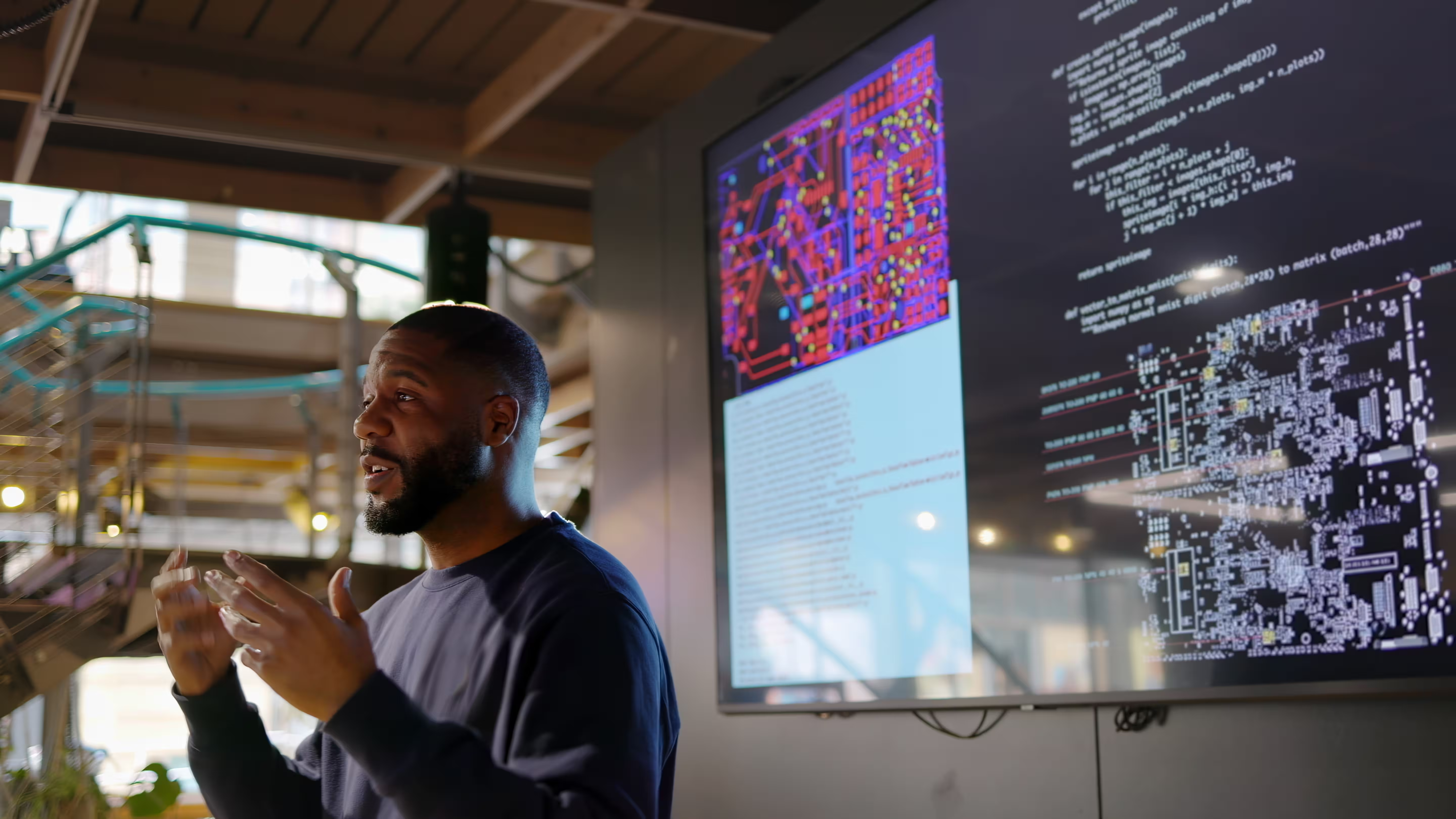AI: the new workhorse of FIs
There’s a lot of buzz about the implications of AI for the future, but its real value today is in doing the heavy lifting for industries like financial services.
Certainly, the news about artificial intelligence (AI) can tend toward the sensational: stories about people using AI to impersonate public figures, create original art, generate tv commercials—not to mention videos of kittens with light sabers. Some predict that AI will soon replace skilled workers, crash stock markets . . . maybe even take over the world.
And surely the world we live in is changing rapidly because of it—and will continue to do so.
But in another sense, AI is nothing new. For more than a decade, online bookstores have been suggesting books based on our previous browsing and purchases. That’s AI. Television streaming services analyze our viewing habits and show us content we might enjoy. Also AI. Social media feeds use AI algorithms to display content we’re likely to engage with and search engines use the fundamental building blocks of AI to display ads for boots when they know we’ve been shopping online for them. Smart home systems turn the lights off and on—all we have to do is ask. That, too, is possible because of a type of AI called “generative AI” or “gen AI”.
Fundamentally, gen AI is really just about generating new data based on patterns, structure and input. Automating simple functions. On, off—like BASIC code from the 1960s. (Though it’s a mind-boggling amount of on and off.)
FIs are already realizing tangible benefits from AI
Today in financial services, gen AI is here and now—not pie in the sky. And it’s working hard. Financial institutions (FIs) are already realizing tangible, bottom-line-influencing benefits from it.
AI is having a real impact for FIs in:
Fraud detection and prevention—AI can analyze vast amounts of transaction data quickly to identify patterns and anomalies. This helps FIs detect fraudulent activity faster and more accurately than traditional methods, saving millions and protecting customers.
Risk management—AI can analyze a borrower's financial situation, credit history and other data points to assess their risk of defaulting on a loan. This helps FIs make more informed lending decisions, reducing their risk exposure so they can offer better rates to qualified borrowers.
Customer service—AI-driven chatbots are becoming common in banking, providing 24/7 customer support for simple questions and tasks. This gives human customer service representatives more time and focus for handling more complex issues, improving overall customer satisfaction.
AI is helping FIs increase productivity through everyday efficiencies that improve processes, maximize performance and manage costs.
Personal banking—AI can analyze customer data to understand their financial habits and needs. This allows FIs to recommend products and services based on what the customer needs and wants, such as suggesting a savings account based on spending habits or recommending an investment portfolio based on risk tolerance.
Operations—AI can automate many repetitive back-office tasks, such as loan processing, account reconciliation and compliance checks. This frees FI employees to focus on more strategic work and improves overall operational efficiency.
Market analysis and algorithmic trading—AI can analyze vast amounts of market data to identify trends and predict future movements. This allows FIs to make more informed investment decisions and develop more sophisticated trading algorithms.
While AI is still a developing field, it’s already offering FIs valuable benefits. And, as AI technology continues to grow, the financial services sector will have access to more and better innovative capabilities.
The potential value of AI to FIs long term
The McKinsey Global Institute (MGI) estimates that across the global banking sector, generative AI could add between $200 billion and $340 billion in value annually, or 2.8 to 4.7% of total banking industry revenues.
PwC’s Global Artificial Intelligence study found that, by 2030, AI could contribute up to $15.7 trillion to the global economy by 2030.
The possibilities are virtually unlimited—as is the potential value.
AI could add $200 to $340 billion in value annually to total banking industry revenues. By 2030, it could add $15.7 trillion to the global economy.
The right strategy and operating model are key to a FI’s success
To maximize its value, a FI’s AI strategy must have good, clean, reliable data to work with. (The old saying from the early days of computing also still applies: “Garbage in, garbage out”.) Capturing proprietary customer behavior data via touch points within the institution, such as the ATM, is the key to this.
And just as good data is the key to a FI’s success with AI, a strategic operating model and the right talent are the foundation it needs to capture the AI’s full potential.
The operating model can be either centralized or decentralized. A more centralized model may work best for initial speed of implementation—this can make the buy-in process more efficient—with gradual conversion to more decentralized operations with decision-making by individual business units over time as appropriate.
FIs that prioritize agility in processes and decision-making will have an advantage in executing AI programs.
FIs to watch for AI innovation
Two prominent FIs that are leading the way in AI, NYC-based JPMorgan Chase and London-based HSBC, are doing so using diametrically opposite AI strategies and operating models:
• JPMorgan Chase has established a centralized AI unit, leveraging an operating model that facilitates collaboration and efficient scaling of AI initiatives. It includes:
- Prioritizing AI use cases that align with their overall business goals for maximum value and risk management
- Setting common standards for data practices and technology architecture for consistency and smoother workflows
- Recruiting top AI talent while also retraining current staff to bridge the business-technology gap
• HSBC, on the other hand, is implementing a largely decentralized AI operating model, empowering business units to develop and deploy AI solutions customized for their needs. This fosters innovation and speeds implementation, especially for niche applications. The HSBC model focuses on:
- Prioritizing AI projects that directly translate to business benefits, such as improved customer service or fraud detection
- Encouraging experimentation with AI and machine learning models for the flexibility to allow rapid learning and adjustments based on results
- Knowledge sharing among business units to avoid duplication of efforts and collaborate on best practices
So, should your FI adopt a centralized or decentralized AI operating model? That path forward is up to your FI. There’s no one-size-fits-all approach to AI in banking. The best strategy and operating model will depend on the specific FI’s size, structure, and goals. But as the examples above illustrate, a successful implementation involves a clear vision, alignment with business objectives and a focus on developing the right talent and infrastructure.
Putting the “AI” in ATM maintenance
AI is also making a difference to FIs’ bottom lines and customer care right at the ATM.
By using AI to mitigate ATM maintenance issues and prevent service call backlogs and revisits, AI-assisted technicians can keep your ATMs up and running when your customers want to use them. And better ATM uptimes lead directly to increasing customer satisfaction and building positive regard for your brand.
It’s also helping to improve onboarding of new field technicians—shortening the learning curve so they can perform as effectively as a 10-year or longer technician. Using AI to access shared knowledge can help technicians and engineers complete service calls faster so they can handle more calls per day, and that time adds up.
“We’re using AI to help our customer engineers prevent service call backlogs. For FI customers, that means better customer satisfaction." —Patty Watson, chief information and technology officer, NCR Atleos
Here’s an example: a service call typically takes an average of 90 minutes. If gen AI can help a technician trim 6 or 7% of that time, they can save an average of five minutes per service call—getting to the next call faster.
And the time that is saved adds up: five minutes saved on 1,000 service calls converts to a savings of 5,000 minutes, or about 83 hours—which can mean getting to more service calls faster for more ATM uptime.
AI can analyze use patterns in ATMs and provide insights into when those ATMs will need maintenance, so potential service issues can be addressed before they occur—for continually improving service performance. It can monitor withdrawal and deposit patterns to better align cash replenishment schedules with the need at each ATM.
FIs must take the reins of AI to remain competitive
In short, AI is a whole new frontier. Those FIs that find strategic ways to take advantage of it—in both the long term and the short term—will have opportunities to improve both their competitiveness and their balance sheets.
Let’s explore what’s possible for your business. Our team is ready to connect and discuss tailored solutions that meet your goals.
Thank you for reaching out. A member of our team will be in touch shortly to continue the conversation.







%20(1).jpg)





%20(1).jpg)

%20(1).jpg)




%20(1).jpg)
%20(1).jpg)
%20(1).jpg)

%20(1).jpg)
%20(1).jpg)
.jpg)
.jpg)
.jpg)
%20(1).jpg)
.jpg)
.jpg)
.jpg)




.jpg)
.jpg)
.jpg)
.jpg)
